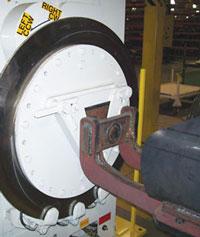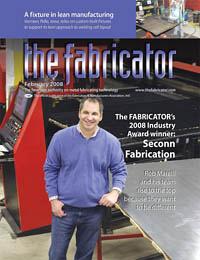Senior Editor
- FMA
- The Fabricator
- FABTECH
- Canadian Metalworking
Categories
- Additive Manufacturing
- Aluminum Welding
- Arc Welding
- Assembly and Joining
- Automation and Robotics
- Bending and Forming
- Consumables
- Cutting and Weld Prep
- Electric Vehicles
- En Español
- Finishing
- Hydroforming
- Laser Cutting
- Laser Welding
- Machining
- Manufacturing Software
- Materials Handling
- Metals/Materials
- Oxyfuel Cutting
- Plasma Cutting
- Power Tools
- Punching and Other Holemaking
- Roll Forming
- Safety
- Sawing
- Shearing
- Shop Management
- Testing and Measuring
- Tube and Pipe Fabrication
- Tube and Pipe Production
- Waterjet Cutting
Industry Directory
Webcasts
Podcasts
FAB 40
Advertise
Subscribe
Account Login
Search
Innovative workholding streamlines welding at Vermeer
Lean thinking helps weed out inefficiencies in the weld cell
- By Tim Heston
- February 12, 2008
- Article
- Arc Welding
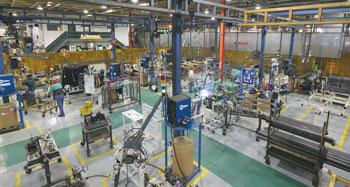
Lean manufacturing drove Vermeer to organize weld cells for maximum productivity. Whenever possible, the company places fixtures in the weld cell, within the operator's reach.
A decade ago welders at heavy-equipment manufacturer Vermeer Corp. regularly went on a fixture hunt. Welders would leave the work area to find the right fixture in an unorganized tool storage yard outside, bring it back, and perform setup, though those setups were far from ideal. Many products--ranging from brush chippers and trenchers to horizontal directional drill machines--required welders to weld vertically or overhead in cluttered work areas.
That process wasn't very productive at all, said David Landon, manager of weld engineering and missions support at Vermeer. Something had to change.
The change started in 1997 when the company adopted what then was an emerging concept for many in the industry: lean manufacturing. An outside Vermeer board member worked with office furniture-maker HON Manufacturing, a lean pioneer, and he convinced the Vermeer management team to take the plunge. "He told us, 'You can't keep adding buildings and machinery,'"recalled Co-CEO Mary Vermeer-Andringa. "'You need to be able to grow without adding floor space or capital.' At the time, this was totally foreign to us."
Not anymore, and the welding team has felt the benefit.
Leaning out the Weld Cell
Due to rigorous 5S (separate, sort, shine, standardize, and sustain) and single-piece part flow efforts, the welding operation has become cleaner, more efficient, and, most important, safer, Landon explained.
Before lean, he said, "the weld cell layout was a hodgepodge. We would have welding machines on the floor, collecting dust, and when you have that you have maintenance issues."Beside each welding machine sat wire drums that required a forklift to move them between weld cells. All this clutter didn't make life easy for the welder, who had to maneuver in and out to go on the hunt for fixtures and other setup components.
So early on welders came up with ideas, fostered through kaizen brainstorming sessions, to clear the mess. Welding machines were standardized; the company now uses pulsed welding machines from Miller Electric. They placed those machines on pedestals, which help keep the welding equipment clean, and wire drums are placed underneath, clearing floor space.
Drums now sit on wheeled carts, so when welders switch out consumables, they wheel the correct wire drum into place in a matter of minutes. At the same time, the company moved the wire feeders above the weld area on booms, from which hang the welding cables, off the floor and out of the way (see Figure 1).
The Importance of Ergonomics
Good ergonomics almost always leads to greater efficiency, Landon explained, as well as happier employees. The fewer repetitive or awkward moves a welder makes during a shift, the better--and to that end, smart fixturing plays a big role.
As Landon pointed out, "One of lean's seven wastes is transportation," and the welder, walking between the weld cell and the backyard, had plenty of it. "So we organized all the fixtures each welder is likely to need in his weld cell, so he didn't have to hunt them down. Now, whenever possible, we keep all welding fixtures permanently located in the cell, within the operator's reach."
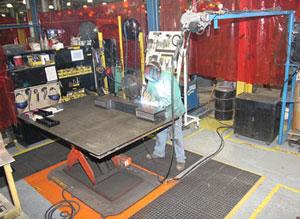
Figure 1 After implementing 5S, Vermeer organized weld cells for efficiency and ergonomics, placing the wire drum on a wheeled cart and installing a lift table.
Manufacturing heavy equipment means working with heavy parts that sometimes aren't the easiest to weld. Consider a massive cutter drum component for a recent product launch. The conventional way to position it for welding would be to load the part onto a fixture with a hoist. An operator would fixture the part, tack it, weld, put down his gun, release the fixture, operate the hoist again to turn the large component 180 degrees, refixture it, and, finally, resume welding. Looking at all these steps, it doesn't take long to see that the welder spends more time positioning the part than actually welding it--not a good thing.
In this case, the company developed a worm-gear-crank rotational fixture (see Figure 2). To access another side, the welder simply rotates the table 180 degrees. "We reduced the required floor space and [increased efficiency] at the point of use,"Landon said.
Efficiencies at the point of use can always stand some tweaking. For instance, welders aren't all the same height, and each worker approaches a weld joint a little differently. To customize the equipment for each welder so it is ergonomically correct, the company uses hand-crank scissor-lift tables, so the welder can move the workpiece to the most comfortable height. Vermeer employees use hydraulic lifts that carry a few extremely heavy parts, but for the most part, they keep it simple. The mechanical reductions gained through worm gears in the hand-crank system make it easy enough for welders to adjust for most parts. This, Landon added, exemplifies one of the company's principles in implementing lean: creativity before capital. Why spend money on a complex hydraulic table when a manual mechanical system will do the job, with no hydraulic or electric lines required?
SMED in the Weld Cell
For some parts using rotating positioners, welders had to hand-tighten six to eight bolts. To streamline things, employees developed a quick-coupling system that allows welders to clamp and unclamp workpieces with a single quick-coupler bar, a fixture assembly Landon's team calls the "flying V"(see Figure 3). A male V descends and fits with a female V, and, when a single bar is affixed to the plate and Vs, the entire assembly is held in place. These fixture assemblies are also "keyed in"to prevent heavy parts from being placed on positioners not designed to take the weight. A flying V designed to hold a heavy assembly won't fit on a positioner unless it is rated for heavy parts.
"This kind of thinking followed what we learned about SMED [single-minute exchange of dies],"Landon said. "Now something that used to take up to an hour now takes about five minutes."
He added that not every efficiency gain need be "amazingly innovative or creative. We sometimes find additional places on parts where we can incorporate a tab-and-slot arrangement [to mate the parts and eliminate tack welding]. Other times we may discover we can use gang clamps, rather than a series of individual clamps, so we can throw multiple clamps all at once. Sometimes we develop slide stops rather than threaded stops that must be screwed into place.
"These changes are all based on common SMED thinking and other principles,"Landon added. "We just incorporated these principles into our welding fixtures."
Fresh Eyes
Without the company's time commitment to lean, most of these innovations would never have occurred, Landon explained. Continuous improvement never stops, and the company is religious about holding weeklong kaizen events. For every event six to eight people get together; a third comes from operations, another third from management, and the rest from other plants or business areas, like purchasing or accounting. "We need those people who don't deal with the problem day to day,"he said. "They bring a fresh set of eyes."
What will those fresh eyes dream up next? As Landon put it, Vermeer employees are looking for that George Jetson fixture. "Remember how Jetson used to pull something out of his pocket, and it would fold into this big thing? That would be something great."Joking aside, he said Vermeer recognizes that finding waste has a lot to do with holding the workpiece in the most efficient, safe, and best orientation--and the fewer times that part must be fixtured, the better.
Indeed, when it comes to lean, fixturing truly is where the rubber hits the road, he concluded, and each workholding efficiency makes the ride a little smoother.
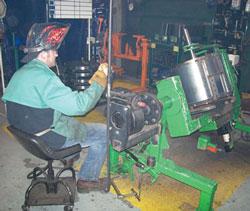
Figure 2 A rotational fixture holds a cutter drum for a brush chipper. The operator cranks the handle on the worm gear, and the fixture rotates.
Safety: A good starting point for lean
Mary Vermeer-Andringa, co-CEO of Pella, Iowa-based Vermeer Corp., was trained as an educator. "Drawing from that," she said, "I really try to see inside people's heads, to get people excited about a process."
That training came in handy during the late 1990s when the company started its journey down the lean manufacturing path. Those first lean steps concentrated on worker health and safety, including ergonomics--for good reason. What better way to get employees excited about lean than to make their jobs easier? Put another way, why should a worker--be it a laser cutting operator or welder--get excited about lean when the word layoff can be the first thing that comes to mind?
Besides stating that no employee would lose his or her job because of lean manufacturing, Andringa knew that to achieve full employee buy-in, the company needed to improve their day-to-day work environment.
"A lean environment is a healthy environment," added David Landon, manager of weld engineering and missions support. For instance, what welder likes to weld overhead all day? It can be ergonomically disastrous, he said, and can result in subpar work. Besides, welding overhead isn't as efficient as welding flat. Why not develop a way to rotate the part quickly, so the process can be faster, better, and safe all at the same time?
Andringa admitted it took real commitment to stick with the program. Vermeer started its lean program in 1997, just a few years before the dot-com bust, when the company's revenue plunged more than 60 percent. But without lean, the company would have gone through the recession with rocky financial footing, she explained, and it wouldn't be where it is now--with volumes and revenues just a hair shy of prerecession levels.
Vermeer Corp., 1210 Vermeer Road E., Pella, IA 50219, 641-628-3141, www.vermeer.com
About the Author

Tim Heston
2135 Point Blvd
Elgin, IL 60123
815-381-1314
Tim Heston, The Fabricator's senior editor, has covered the metal fabrication industry since 1998, starting his career at the American Welding Society's Welding Journal. Since then he has covered the full range of metal fabrication processes, from stamping, bending, and cutting to grinding and polishing. He joined The Fabricator's staff in October 2007.
Related Companies
subscribe now

The Fabricator is North America's leading magazine for the metal forming and fabricating industry. The magazine delivers the news, technical articles, and case histories that enable fabricators to do their jobs more efficiently. The Fabricator has served the industry since 1970.
start your free subscription- Stay connected from anywhere

Easily access valuable industry resources now with full access to the digital edition of The Fabricator.

Easily access valuable industry resources now with full access to the digital edition of The Welder.

Easily access valuable industry resources now with full access to the digital edition of The Tube and Pipe Journal.
- Podcasting
- Podcast:
- The Fabricator Podcast
- Published:
- 04/16/2024
- Running Time:
- 63:29
In this episode of The Fabricator Podcast, Caleb Chamberlain, co-founder and CEO of OSH Cut, discusses his company’s...
- Trending Articles
AI, machine learning, and the future of metal fabrication

Employee ownership: The best way to ensure engagement

Steel industry reacts to Nucor’s new weekly published HRC price

Dynamic Metal blossoms with each passing year

Metal fabrication management: A guide for new supervisors

- Industry Events
16th Annual Safety Conference
- April 30 - May 1, 2024
- Elgin,
Pipe and Tube Conference
- May 21 - 22, 2024
- Omaha, NE
World-Class Roll Forming Workshop
- June 5 - 6, 2024
- Louisville, KY
Advanced Laser Application Workshop
- June 25 - 27, 2024
- Novi, MI
























